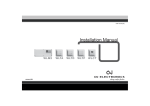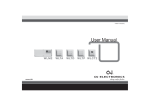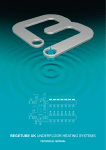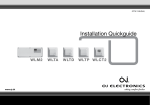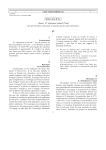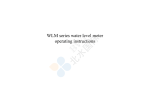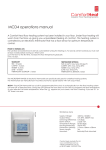Download Master with display type WLM USER MANUAL
Transcript
Lagernummer: 57543A 10/04 (BJ) U S E R M AN U AL Master with display type WLM Introduction The masters type WLM-1FS and WLM-3FS are provided with graphic display to enable simple programming and operations of the unit to be achieved using simple and easy to understand icons and symbols. Moving around in the menu By using the ( ) (UP), and the ( ) (DOWN) you move through the main menu into sub menus. The description of these submenus can be seen below. If a value needs to be changed, then press ( ) (CONFIRM) button once, and alter the value with the ( ) (UP) and ( ) (DOWN ) buttons. Then press ( ) (CONFIRM) to accept the new value. If you wish to reset the master to factory settings, then push the ( ) (CONFIRM) button for 10 sec. until the 6 outputs starts blinking. The master has now been reset to factory settings. Control of room temperature Within the memory of the master, there is a room temperature Setpoint which will apply for all rooms connected to the system. This setting is at 20°C when the unit leaves the factory, but it can be increased or decreased as required. Any change will apply to all rooms on the system unless a clock thermostat is employed (see next para). Using clock thermostat (WLCT-19): If a clock thermostat is used as a zone control for one room or a group of rooms, then all the thermostats within this zone will operate according to the temperatures and times defined in the clock thermostat. However the local thermostats within the group are still capable of being adjusted by ± 4˚C so that some rooms can be set higher or lower than others. The decision as to which thermostats will form part of the clock thermostats group is made by programming the clock thermostat (see instructions for WLCT unit). Any thermostats that are not part of the clock thermostats’ group will operate to the temperature as defined in the master control, but again with the option of local ±4°C adjustment. Using external switch for night setback: The day temperature set point is defaulted to 20°C and the night temperature to 15°C. These default settings can be changed on the master. The current operating set point of the master can be changed from the day temperature into night temperature, by connecting a separate timing device to the master. When the external switch or timer is used to switch to night setback, this will override any time settings in a WLCT clock thermostat, including any thermostats that are part of a group allocated to that clock thermostat. Return to main menu If you are in a submenu and push UP ( ) and DOWN ( ) at the same time you jump back to the menu start position. 20.0ºC Day temperature Temperature set point for all thermostats not part of a clock thermostat group. Push ( ) accept and ( ) ( ) to adjust the set point. 15.0ºC Night temperature When activated via an external timer, this action is valid for all thermostats connected to the master. Night setback can also be activated on individual thermostats (WLTM & WLTD) by using the selector switch and setting to the “night” position. A clock thermostat (WLCT) will automatically switch to night setback at the times programmed into it, as will all the other thermostats which are included in its group. 5.0ºC OFF temperature (frost protection) All thermostats with an override switch (WLTM & WLTD) can be set to an OFF position. This is known as a frost protection position, and if the temperature in the room shoud fall as low as 5°C, the heating will be enabled to prevent frost damage. The 5°C level can be changed in the master module. Limitation of floor temperatures 27.0ºC Max limit temperature for thermostats with limit sensor (floor sensor) 17.0ºC Min limit for thermostats with limit sensor (floor sensor) Supply Water Temperature Control Using supply water sensor for limitation of supply water: A limit sensor should be used with the WLM 1FS & WLM 3FS, but can be used without the weather compensation module (WLOC). In this case the master will control the supply water temperature flowing into the system via the 3 or 4 port mixing valve and actuator. The factory default setting is 45°C, but can be changed via the master display. Using outdoor compensation module for weather compensation When the outdoor compensation module (WLOC) is connected to the system, the master calculates the correct temperature, taking into account the heat losses that will vary depending on the outdoor temperature, and the room temperature requirements of the system. For example, on a day when the outdoor temperature is 12°C, it is possible to run the heating system with a supply water temperature of only 35°C. this ensures economical running of the boilers, and comfortable room conditions throughout the year. The max allowed supply water temperatur prevents excessive water temperatures if the outdoor temperature becomes extremely cold, e.g. - 30°C. 55ºC Max allowed supply water temperature. -3ºC Winter Outdoor temperature 45ºC Winter Design supply water temperature at outdoor temperature –3°C Design supply water temperature if used without outdoor compensation module. Return 25ºC Summer Outdoor temperature 30ºC Summer Supply water temperature at outdoor temperature 25ºC Return Max supply temperture The max allowed supply water temperature is set according to the design requirements of the installation (line A on the curve). This is the safely maximum. Weather compensation Winter A design outdoor temperature and the corresponding design supply water temperature are set (point B). To increase the heat output, adjust the supply water temperature higher, until you feel comfortable (we recommend only a 2 degree adjustment of this temperature at a time, and timer allowed for the system to respond). Summer An outdoor temperature and the corresponding supply water temperature are set (point C). To increase the heat output, adjust the supply water temperature higher (we recommend only a 2 degree adjustment of this temperature at a time, and timer allowed for the system to respond) The master calculates the intersection point D Compensation for outdoor temperature can only be done if an outdoor compensation module (WLOC) is installed. Without outdoor compensation module the Master will adjust after allowed supply water temperature 45°C. Service menu Push accept to enter No setting values can be changed under the service menu. The controller will automatically return to main menu after 30 minutes. 1.6 Software version OK no failures E1 to E9 if a failure is present. See below for explanation. Submenu 2 Push accept to enter and see which unit has the failure Submenu 2a -2.4°C Read-out Outdoor temperature 49.2ºC Read-out Actual supply water temperature 44.4ºC Read-out Calculated setpoint by the controller for the supply water temperature 3.5V --24.0°C 22.9°C Read-out Control signal for the mixing valve. At 10V the mixing valve is fully open. Read-out Room temperature in the different rooms. Push accept (V) and up or down to select another room The room temperature is shown in the middle. If a limitation sensor is connected the measured temperature is shown below or above the room temperature. · if the thermostat is for minimum limitation the value is shown below · If the thermostat is set for max. limitation the value is shown above. Return Settings Factory settings House temperature 20ºC Night temperature 15°C Off temperature 5°C Floor Limit temp high 27°C Floor Limit temp low 17°C Max water temperature 55°C Own settings Factory settings Weather compensation Outdoor temperature -3ºC Cold (winter) water temperature 45ºC Weather compensation Outdoor temperature 25ºC Warm (summer) water temperature 30ºC Software version 1.60 Own settings ERROR/FAULT MESSAGES AND TROUBLE SHOOTING During normal operation the green power LED will be ON when the master control is energised. The red output LED’s (1 to 6 on the master, and 7 to 14 on the add-on modules) will indicate if the channel output relay is ON/OFF. An error / fault message is shown by flashing the green power LED or one of the 6 red output LED’s. From the number of flashes on any one LED, the problem can be diagnosed, and identified from the following: The error number will be indicated by the number of flashes, with a pause of less than a 1/2 second between the flashes. The indication will be followed by a pause of 2 seconds, following which the sequence will be repeated. The failure code can also be seen in the service menu (submenu 2). Flashing Power LED (green) E1, 1 flash Ô One or more thermostats that are set to channel 0 or channel 15 are no longer sending data to the master control. The fault is corrected by replacing the thermostat. The master will need to be HARD RESET (see below) (NOTE: If the thermostat is of the WIRELESS type, the error /fault message could be an indication that the power has failed, and that the internal battery of the thermostat needs to be replaced) E2, 2 flashes Ô One or more thermostats have been set to a channel number which does not exist in the system. For example, the message will occur if the units are set to channels 7..14 and the required add on (AO) modules are not found in the system. The error is corrected by setting the channel number of the thermostat to a channel that does exist within the installed master/add on module system. E3, 3 flashes Ô Both AO modules have been set to the same channel group (either 7 to 10 or 11 to 14). The error is corrected by moving the selector switch placed in the lower right corner of the PCB of the AO module to position A for output 7 to 10 or to position B for output 11 to 14. Only two AO modules can be used with any one master. E4, 4 flashes Ô The outdoor compensation module (WLOC) is defective. The fault is corrected by changing the outdoor compensation module. If the module has been removed deliberately to change the operation of the system, follow the HARD RESET instruction below. E5, 5 flashes Ô The external limit sensor (type ETF-1899A) is defective. The fault is corrected by changing the temperature sensor. If the sensor has been removed deliberately to change the operation of the system, follow the HARD RESET instruction below. E6, 6 flashes Ô Internal overheating. The master has its own internal safety temperature protection system. The problem is corrected by improving the ventilation around the master module. E7, 7 flashes Ô Defective internal overheat sensor. The Master will control as normal, however the protection against internal over heating is no longer active. The fault can only be corrected by replacing the master module. E8, 8 flashes Ô The communication to an AO module has been lost. The fault is corrected by re-establishing the connection to the AO module or by changing the AO module if it is defective - or if it has been deliberately removed, with a HARD RESET. E9, 9 flashes Ô Indicates total number of input units exceeded. Please refer to factory or your local service engineer. Only one error/fault condition can be shown at a time. If more than one error occurs, they will be prioritised in the shown sequence (1..9). Flashing output LED (red): The appropriate output channel LED can flash, indicating that the thermostat on that channel has a fault/error. The failure code can also be seen in the service menu (submenu 2a). Ô The master has lost communication to the thermostat. The fault is corrected by re-establishing the connection to the thermostat and the fault condition will be automatically reset once correct communication is resumed. If the thermostat is defective and has to be changed, or if it has been deliberately removed, it is necessary to make a HARD RESET. (NOTE: If the thermostat is of the WIRELESS type, the error /fault message could be an indication that the power has failed, and that the internal battery of the thermostat needs to be replaced) E2, 2 flashes Ô The internal sensor in the thermostat is defective. The fault can only be corrected by replacing the thermostat. Remember to make a HARD RESET after installing the new thermostat. E3, 3 flashes Ô The limit sensor on the thermostat is defective. Replace the faulty sensor. Reset is NOT required. E4, 4 flashes Ô Defective WLCT clock thermostat. If a clock thermostat operating a group of thermostats becomes defective, the remaining thermostats will control within the maximum and minimum limits programmed into the clock thermostat. E1, 1 flash RESET There are 3 different reset actions that can be used. SOFT RESET If the (V) button is activated for 3 seconds, a SOFT RESET will be initiated. (Indicated by all the red output LED’s(1-6) lighting in sequence when the ‘V’ button is released). A SOFT RESET will clear failure messages, in the next 5 minutes. HARD RESET If the ‘V’ button is pressed for 8 seconds, a HARD RESET will be initiated. (Indicated by flashes of all six red output LED’s and the green power LED simultaneously). This reset will remove from the system any thermostat unit with a defective input sensor, or a defective AO module. The fault message will be reset but the defective items will no longer participate in the system. Once a defective unit is replaced, the new unit will automatically be recognised by the master control and become part of the system. To erase the identity of the defective component from the master memory a HARD RESET must be performed Hard resets do not alter the temperature settings already programmed into the master control. FACTORY RESET If the (V) button is pressed for more than 10 seconds, a total factory reset will be initiated. This is indicated through flashes of channel LEDs 1,3, and 5 alternating with channel LEDs 2, 4, and 6 (while the “V” button is pressed). A factory reset will put all programmed temperature settings back to the factory defaults. It will also remove all thermostats from the master memory, and reset the system to accept only those thermostats that are functioning correctly. OJ Electronics A/S Stenager 13B · DK-6400 Sønderborg Tel +45 73 12 13 14 · Fax +45 73 12 13 13 www.oj.dk




